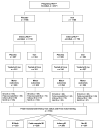Timing, duration, and severity of iron deficiency in early development and motor outcomes at 9 months
- PMID: 29235557
- PMCID: PMC5843498
- DOI: 10.1038/s41430-017-0015-8
Timing, duration, and severity of iron deficiency in early development and motor outcomes at 9 months
Abstract
Background/objectives: Poorer motor development is reported in infants with iron deficiency (ID). The role of timing, duration and severity is unclear. We assessed relations between ID timing, duration, and severity and gross motor scores, neurological integrity, and motor behavior quality at 9 months.
Subjects/methods: Iron status was determined at birth and 9 months in otherwise healthy term Chinese infants. The 9-month motor evaluation included the Peabody Developmental Motor Scale (PDMS-2), Infant Neurological International Battery (INFANIB), and motor quality factor. Motor outcomes were analyzed by ID timing (fetal-neonatal, infancy), duration, and severity. For severity, we also considered maternal iron status.
Results: The data were available for 1194 infants. Iron status was classified as fetal-neonatal and infancy ID (n = 253), fetal-neonatal ID (n = 256), infancy ID (n = 288), and not ID (n = 397). Compared with not ID, infants with fetal-neonatal or infancy ID had lower locomotion scores (effect size ds = 0.19, 0.18) and those with ID in both periods (longer duration) had lower locomotion and overall PDMS-2 gross motor scores (ds = 0.20, 0.18); ID groups did not differ. More severe ID in late pregnancy was associated with lower INFANIB Vestibular function (p = 0.01), and total score (p = 0.03). More severe ID in infancy was associated with lower scores for locomotion (p = 0.03), overall gross motor (p = 0.05).
Conclusions: Fetal-neonatal and/or infancy ID was associated with lower overall gross motor development and locomotion test scores at 9 months. Associations with ID severity varied by ID timing: more severe ID in late pregnancy, poorer neurological integrity; more severe ID in infancy, poorer gross motor development.
Conflict of interest statement
References
-
- Murray GK, Veijola J, Moilanen K, Miettunen J, Glahn DC, Cannon TD, et al. Infant motor development is associated with adult cognitive categorisation in a longitudinal birth cohort study. J Child Psychol Psychiatry. 2006;47:25–29. - PubMed
-
- Clearfield MW. Learning to walk changes infants’ social interactions. Infant Beh Dev. 2011;34:15–25. - PubMed
-
- Stevens GA, Finucane MM, De-Regil LM, Paciorek CJ, Flaxman SR, Branca F, et al. Global, regional, and national trends in haemoglobin concentration and prevalence of total and severe anaemia in children and pregnant and non-pregnant women for 1995–2011: A systematic analysis of population-representative data. Lancet Glob Health. 2013;1:e16–e25. - PMC - PubMed
Publication types
MeSH terms
Substances
Grants and funding
LinkOut - more resources
Full Text Sources
Other Literature Sources
Medical


